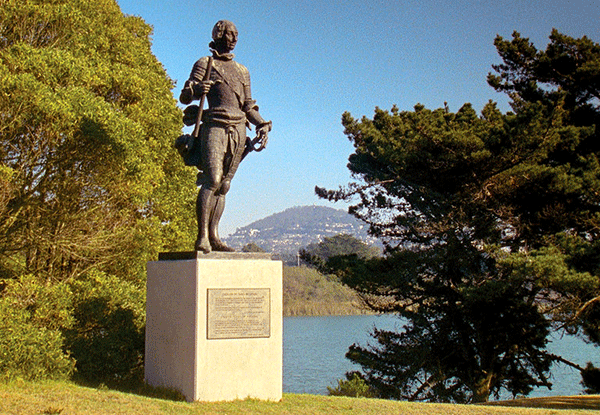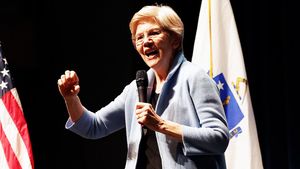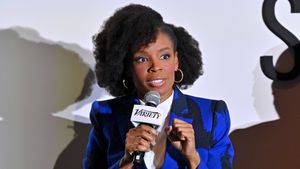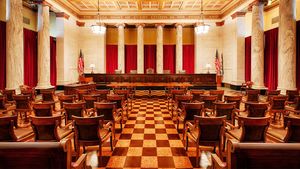Award-winning filmmaker Jenni Olson's rangy, Proustean filmed essay, The Royal Road, begins with the most innocous of images--nondescript urban California--then dives into the history of the occupation of California and of filmmaking, and Olson's obsession with a beguileing Angeleno (while comparing herself to Cassanova). Out.com speaks to Olson about the film.
The premise of your film is wild. You describe the visit to an unrequited love, traveling along California's El Camino Real (the missionaries' "royal road"), while recounting the Mexican American War, early Hollywood, and your thoughts on butchness--among other topics. What inspired this mix of topics?
As a writer I have always enjoyed the first-person diary format as a storytelling mode--especially with an emphasis on some of my unique personal butch perspectives that I think are not so often conveyed on film. Using the colloquial, confessional voice creates an intimacy with the viewer and also helps them access their own vulnerability. By combining my intimate voiceover with the dry, factual details of various social justice issues I can achieve some of the goals of a more conventional documentary. In my previous feature, The Joy of Life, I explored the history of suicide and the Golden Gate Bridge (with the goal of generating awareness of the problem as a public health issue). With The Royal Road I wanted to shed more light on the historical injustices of the Spanish colonization of California (the decimation of the Native American people) and the subsequent Mexican American War in which the U.S. forcefully seized California and the American Southwest from the Republic of Mexico. The mix of topics is eclectic and unconventional but there are connective tissues, sometimes direct and often oblique, that prompt each digression and ultimately create a complete, coherent if somewhat poetic manifesto.
Your monologue is mostly heard over 16mm film of urban California landscapes, sometimes so motionless they look like still images. How did you come to this visual concept?
I was very influenced by a film called Massillon by William E. Jones that I saw in 1991 at Outfest, the Los Angeles LGBT Film Festival. It's an amazing film--consisting entirely of 16mm urban landscapes and voiceover as Jones recounts stories of growing up gay in Ohio and moving to California. We became good friends after that (I even did an interview with him for The Advocate that year). It took me several years to get serious about making my own films but that format resonated with me so strongly I just decided that was the most interesting and compelling way to express my artistic vision.
There aren't any people depicted, but the evidence of them is everywhere.
That's such an interesting way of describing it. I realized early on in shooting that I didn't want any people in the shots. One of the most powerful things about my films, more powerful with each passing year, is that the viewer can project themselves into this depopulated landscape and have the experience of being alone in a quiet urban environment. I have this very complicated relationship with nostalgia--an agenda for the redemption of nostalgia really. It's not that I literally want things to go back to being how they were (the traditional concept of nostalgia) but that I want to remain connected to certain human qualities I believe are associated with an experience of the environment where we are less distracted, more present in the physical world. It can be very hard to describe this experience but when audiences walk out of my films after having spent more than an hour alone in the city they are viscerally impacted. And of course one of the most notable aspects of my landscapes is that they have a timeless quality to them--I very intentionally crop out more contemporary indicators like billboards, bright yellow crosswalks. As much as possible I want it to be a timeless, and really kind of mundane, portrait of the landscape and the built environment. I love the idea that it is at its purest level a documentary of the landscape itself and I definitely have an underlying philosophical, almost spiritual agenda about it. I have a line in the film where I say: "These images serve as a reminder of what once was, and as a prompt to appreciate what now is."
How do you think we would be different if we did remember the western U.S.'s history the way we remember that of the east? Your film has me thinking a lot about borders (certainly a big topic in the general election), and how they move around people, e.g., the west of North America was the Republic of Mexico before it was ceded to the U.S.A. Borders can seem so arbitrary. Are they?
Well, of course the truth is that we (the royal We of the national mythology we want to believe about ourselves) have a hard time remembering all of the parts of our history where we were the bad guys. And of course it is just human nature. As individuals, and as a society, we have justifications and rationalizations for everything. The Spanish colonization of the west is popularly forgiven for its supposed good intentions of trying to "civilize" the people who were living her. As white Anglo-Americans who are the ultimate beneficiaries (and also ultimately victims as well) of that colonization it's extremely difficult to take on the full moral implications of where we are right now in the big picture of history. There is an overriding tendency to explain it all away as some kind of inevitable set of forces of human nature. Amongst the victors, the predominant mythology of the Mexican American War (if Americans are even aware of it at all) has been that it was inevitable that all that land would belong to the U.S. The refusal to learn about and acknowledge the injustices perpetrated by the U.S. upon Mexico--adds the insult of ignorance to the injury. Your question about borders reminds me of the famous phrase of the Latino Civil Rights movement: "We didn't cross the border, the border crossed us." I hope my film is able to shed a little bit of light and be part of generating a higher level of dialogue and understanding.
What did filming the landscapes of San Francisco do to your understanding of them?
The landscape of San Francisco is endlessly fascinating to me. The city is a seven-mile square, water-bound peninsula of forty-eight hills that continue to yield unexpected vistas even after twenty-five years of exploration. I've learned an enormous amount about people and places and the ever-changing light here. But ultimately I think my filmmaking process is more about understanding myself than about understanding the landscape. As I say in the film: "Like many people, I came here to reinvent myself and to find happiness. This city was built on people like me: pilgrims trying to find themselves, in a place where crazy chosen paths are a virtue and self-discovery is a civic value."
The Royal Road has definitely been a crazy chosen path. And I'm happy to say it has produced a certain amount of self-discovery. I'm also happy to say that as this film makes its way into the larger world I'm in the very early stages of writing my next film, the third part of this trilogy, it uses the same approach of 16mm filmed landscapes and essayistic voiceover. In keeping with my efforts at the redemption of nostalgia it's called, The Quiet World.
The Royal Road is now available as a DVD from Wolfe Video, and on a number of streaming platforms: Vimeo, iTunes, VUDU, Xbox, GooglePlay, Amazon, and WolfeOnDemand



























































































